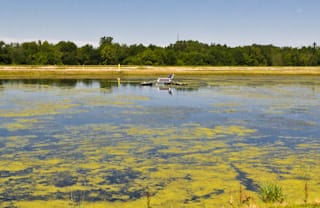The dog days of summer have arrived in dramatic fashion. The heat wave of the past few weeks spanned nearly the entire country. This weather can not only have adverse affects on our comfort, perspiration, and electric bills, it can also negatively affect wastewater treatment lagoons.
We at Triplepoint thought it would be helpful to write a 3-part blog series discussing the three main side effects of summer heat on wastewater lagoons. This is Part 1, which will deal with wastewater lagoon algae control: causes, effects, and solutions.
Why algae grows on your wastewater lagoon in the summer:
- High nutrient levels—Nutrient levels in the water are the main determinant in how
Filamentous algae covers portions of this lagoon despite the solar-powered mixer extensively algae, duckweed, and other vegetation will grow. BOD, nitrogen and phosphorus are the main culprits here. Obviously, having high nutrient levels in a wastewater lagoon is inevitable. However, extensive lagoon algae growth can be an indication that your system is not doing a good enough job of treating the BOD and other nutrients.
- Increased water temperatures—Algae goes dormant in the winter, the same way that flowers, trees, and grass do. As outdoor temperatures (and the water) warm up, this effect reverses. As the summer goes along, rising temperatures mean that the environment for algae growth just keeps getting better and better.
What happens to your wastewater lagoon because of the algae growth:
- High lagoon TSS—Two of the common types of aquatic growth in wastewater lagoons are 1) duckweed, and 2) microscopic algae. Duckweed covers the surface of the water with millions of bright green leaves. Microscopic algae pervade more of the water column, and turn it a pea green color. Both types of growth can cause a breach in permit for your wastewater lagoon as TSS levels will naturally begin to rise. Check out our article, Troubleshooting High Wastewater Pond TSS, for tips on diagnosing and correcting common TSS issues.
- Low Lagoon DO—It’s well known that algae growth can deplete dissolved oxygen (DO) levels in water. This is especially dangerous when it comes to wastewater lagoons. Without proper DO levels, the level of anaerobic digestion in a lagoon can increase. This can cause deficient treatment, lagoon odors and/or lagoon turnover.
Learn how Ares Aeration® can boost Lagoon DO & Lower Lagoon TSS

How to control wastewater lagoon algae growth in summer:
- Improve Lagoon Treatment—A properly aerated lagoon should only experience minimal algae growth around its edges during the hottest summer months. If your existing aeration system is not functioning properly, with aerators or blowers out of service, fixing them is a necessity. Or, if your aeration system is in need of an upgrade, you may want to consider lagoon aeration alternatives.
- Increase Lagoon Mixing & Water Turbulence—The natural habitat for algae is at the surface of the water. If you disrupt that habitat, you also disrupt the algae growth in your wastewater lagoon. Different lagoon aeration systems will create differing amounts of turbulence. Fine bubble systems create a mild turbulence at the surface of the water, while coarse bubble systems are perhaps the best, as the large bubbles create vigorous turbulence. Surface aeration creates a tremendous amount of turbulence where the actual aerator is located. However, often that mixing energy is not as well distributed throughout the lagoon as compared to a fine or coarse bubble diffused system. Either way, the more turbulence in the water, the better your chances are of treating lagoon algae.


